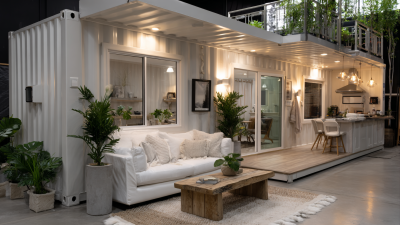Innovative Ways to Transform Shipping Container Rooms into Sustainable Living Spaces
As urban living spaces become increasingly limited and the demand for sustainable solutions rises, the concept of transforming shipping container rooms into viable living environments gains traction. This innovative approach not only capitalizes on the structural integrity and mobility of containers but also promotes a greener lifestyle by repurposing materials that would otherwise contribute to environmental waste. By fusing modern design elements with eco-friendly practices, individuals can create unique, affordable, and functional living spaces that reflect their values and creativity.

In this article, we will explore various tips and strategies for effectively converting a shipping container room into a sustainable haven, from energy-efficient installations to eco-conscious decor choices. Join us on this journey to discover how to embrace sustainable living through the imaginative use of shipping containers.
Creative Design Strategies for Shipping Container Homes
Shipping container homes have gained immense popularity as sustainable living spaces, showcasing creative design strategies that maximize functionality and aesthetics. One innovative approach involves incorporating natural light through strategically placed windows and skylights. This not only enhances the ambiance but also reduces reliance on artificial lighting, promoting energy efficiency. Utilizing shades and overhangs can further control sunlight and heat, ensuring a comfortable indoor climate throughout the year.
Another effective design strategy is the use of modular interiors. By employing movable walls and multifunctional furniture, residents can easily reconfigure their spaces according to their needs. This adaptability is crucial for smaller living areas, allowing residents to transform rooms for different purposes—from a cozy living room to a productive home office—thus maximizing efficiency without compromising style. Furthermore, integrating sustainable materials and finishes, such as reclaimed wood and eco-friendly paints, reinforces the eco-conscious ethos of shipping container homes, creating a harmonious blend of design and sustainability.
Innovative Design Strategies for Shipping Container Homes
Sustainable Materials and Techniques for Container Conversion
Shipping container homes are gaining popularity as sustainable living solutions, with innovative materials and techniques playing a crucial role in their conversion. According to a report by the World Economic Forum, the construction sector is responsible for approximately 39% of global carbon emissions, prompting a shift towards more eco-friendly building practices. Utilizing repurposed shipping containers not only reduces waste but also supports the circular economy by giving new life to materials that would otherwise contribute to landfill pollution.
To enhance sustainability, many container conversions incorporate renewable resources. For instance, using reclaimed wood for interior finishes and insulation made from recycled materials can significantly lower the ecological footprint of these homes. The U.S. Green Building Council states that sustainable building materials can reduce energy consumption by up to 30%. Additionally, integrating solar panels and rainwater harvesting systems can further contribute to a self-sufficient living environment. By embracing these sustainable materials and methods, shipping container homes can serve as a model for environmentally responsible housing in the future.
Energy-Efficient Solutions for Modern Container Living
Shipping container homes are becoming increasingly popular as an innovative solution for sustainable living. With the world shifting towards energy efficiency, these repurposed structures provide a unique canvas for implementing modern energy-efficient solutions. From solar panels to green roofs, there are numerous ways to enhance the sustainability of container living spaces.
One key tip for energy efficiency is to invest in proper insulation. Insulating your container can significantly reduce heating and cooling costs, making your living space more comfortable year-round. Additionally, utilizing energy-efficient appliances can further minimize your carbon footprint while maintaining a modern living environment.
Another effective strategy involves the installation of rainwater harvesting systems. This allows homeowners to collect and use rainwater for irrigation and other non-potable uses, reducing reliance on municipal water supplies. Pairing this with xeriscaping—landscaping that reduces or eliminates the need for irrigation—can lead to a truly sustainable ecosystem surrounding your shipping container home. Embracing these practices not only contributes to a greener lifestyle but also promotes long-term savings on utility costs.
Innovative Ways to Transform Shipping Container Rooms into Sustainable Living Spaces - Energy-Efficient Solutions for Modern Container Living
| Feature | Description | Benefits | Energy Efficiency Rating |
|---|---|---|---|
| Insulation | High-quality insulation materials to maintain temperature. | Reduces energy costs and provides comfort. | A++ |
| Solar Panels | Installation of solar panels to harness renewable energy. | Decreases reliance on grid electricity. | A+ |
| Rainwater Harvesting | System to collect and store rainwater for use. | Promotes water conservation and reduces utility bills. | A |
| LED Lighting | Using LED bulbs for indoor and outdoor lighting. | Energy-efficient and long-lasting lighting solution. | A++ |
| Green Roofs | Planting vegetation on rooftops to improve insulation. | Enhances building aesthetics and reduces heat absorption. | B+ |
Incorporating Green Spaces and Natural Light in Container Designs
 Shipping container rooms are becoming increasingly popular as sustainable living spaces, particularly when designers focus on incorporating green spaces and natural light. By integrating vertical farms and using smart design principles, architects can create eco-friendly environments that enhance the quality of life for residents. For instance, the recent transformation of shipping containers into modern homes and offices showcases how these spaces can be both functional and aesthetically pleasing, while also embracing sustainability.
Shipping container rooms are becoming increasingly popular as sustainable living spaces, particularly when designers focus on incorporating green spaces and natural light. By integrating vertical farms and using smart design principles, architects can create eco-friendly environments that enhance the quality of life for residents. For instance, the recent transformation of shipping containers into modern homes and offices showcases how these spaces can be both functional and aesthetically pleasing, while also embracing sustainability.
Tips: One effective strategy is to maximize natural light by strategically placing windows and skylights, allowing sunlight to flood the interior. Additionally, consider integrating green balconies or rooftop gardens to not only improve aesthetics but also promote biodiversity and provide fresh produce. Embracing materials like reclaimed wood or recycled elements can further minimize the ecological footprint of these innovative structures.
As seen in projects from around the globe, such as those in Brisbane and Hong Kong, the potential for container spaces is limitless. They serve as a canvas for creativity, where every design choice can enhance sustainability. By incorporating nature into these spaces, residents can enjoy a healthier, more connected lifestyle, emphasizing the importance of wellness in our living environments.
Innovative Community Projects Utilizing Shipping Container Homes
Shipping container homes are emerging as a groundbreaking solution for sustainable living, and innovative community projects are at the forefront of this transformation. By repurposing shipping containers, communities are creating affordable, eco-friendly housing solutions that greatly reduce construction waste and carbon footprints. These projects often incorporate green technologies, such as solar panels and rainwater harvesting systems, to enhance environmental sustainability while providing comfortable living spaces.

One inspiring example of this movement is the development of community villages made from repurposed shipping containers. These villages are designed to foster a sense of community, offering shared spaces for social interaction and collaboration. Many projects focus on vulnerable populations, such as the homeless, by providing not just shelter but also support services like job training and mental health resources. This innovative approach demonstrates how shipping container homes can serve as catalysts for social change, promoting both environmental stewardship and community building.

